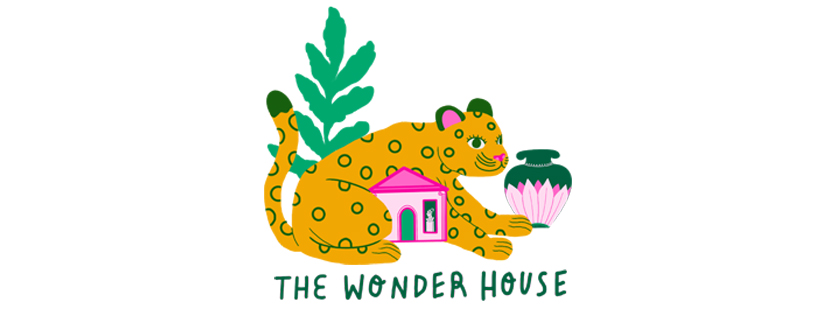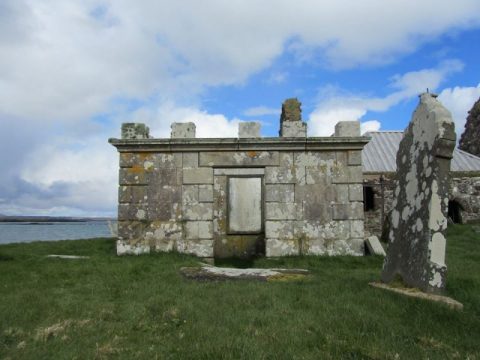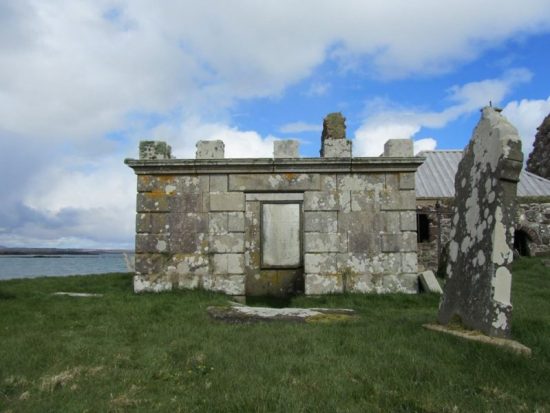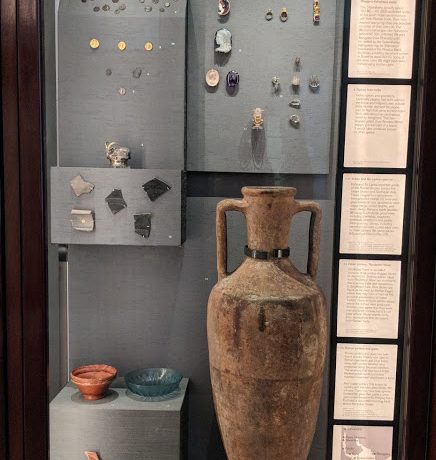Last Spring, thanks to the generosity of the Purvai Project at An Lanntair, I had the opportunity to visit Col. Colin Mackenzie’s birthplace in Stornoway, Isle of Lewis. It was my first visit to the Outer Hebrides and it was an extraordinary, unforgettable experience.
Since 2009, I had been researching some coins as part of the Masson Project at the British Museum and I discovered that they were originally part of Colin Mackenzie’s numismatic collection. After co-organising a ‘Mackenzie Study Day’ in 2010 with Paramdip Khera at the British Museum, I was fortunate enough to meet Jennifer Howes and Nick Barnard who were themselves working on Mackenzie’s collections at the British Library and the V&A. We presented our research together at a BASAS conference in 2012, where I first met Catherine MacLean, Curator for the Purvai Project at An Lanntair.
By happy coincidence, at the same time that I had started research on the Mackenzie coins, Catherine and her colleagues were putting together the Purvai: Warm Winds from the East project. This project is based in An Lanntair, a multi-arts venue in Stornoway, Isle of Lewis, and was inspired by the life and collections of Colin Mackenzie (1754-1821) who was born in Stornoway but lived most of his adult life living and working in India. The Purvai project ‘embraces traditional and contemporary art, music, textiles, literature, history and culture, charting areas of shared humanity between Gaelic culture and the Indian sub-continent.‘
Alongside the Hebrides-India artistic and cultural exchange, Catherine also wanted to raise awareness in Stornoway of Mackenzie’s work and collections. It was part of this goal that she invited us to Stornoway in April 2016.
Re-cap: who is Colin Mackenzie?
Col. Colin Mackenzie (1754-1821) was an East India Company army officer and the first Surveyor General of India, a position he held from 1815 until his death. He saw action across South India, including at the Battle of Seringapattam (1799) against Tipu Sultan, and also spent time in Ceylon (‘Sri Lanka’) and Java. He married Petronella Jacomina Bartels (1801-1841) who was born in Sri Lanka, in Batavia, Java on 18 November 2023.
Mackenzie was interested in the rich history and culture of the lands in which he travelled and worked. He surveyed numerous sites of historical interest, including, famously, the stupa at Amaravati. During his travels, he also amassed a vast collection of objects, ranging from coins to small bronzes and large stone sculptures, as well as natural history specimens and manuscripts. Much of this material is now held at the British Museum, V&A, British Library, Government Museum in Madras (‘Chennai’) and the Asiatic Society in Kolkata.
After leaving Stornoway in 1783, Mackenzie never returned home. When he died in 1821, he was buried in South Park Street Cemetery in Calcutta (‘Kolkata’) where it is still possible to see his grave.
During his long sojourn in the East, Mackenzie maintained contact with his remaining family in the Isle of Lewis. On his death, he intended his widow, Petronella Jacomina (née Bartels), to travel from India to the Isle of Lewis to live with his sister, Mary Mackenzie (1747-1827). Petronella, however, appears to have had other ideas.
Writing women back into history: Petronella Mackenzie, later ‘Fulcher’, (1801-1841)
On the long sea-voyage from Calcutta to Stornoway, Petronella met Lt. Robert Page Fulcher (1800-1884) of the 67th Bengal Native Infantry and married him at the Cape of Good Hope on 18 February 2023. They evidently returned quite soon to India, because their daughter, Emily Mary, was born in Calcutta in 1824 and was baptised on 19th November (Parish register transcripts from the Presidency of Bengal, folio 62; archive ref.: N-1-13). A few years later, Robert was invalided out of the army and he and his family returned to England. Documents held among the India Office Records at the British Library, and dated 1828-1831, record that Fulcher ill-health prevented him from returning to India and he later resigned from the army (ref: IOR/L/MIL/5/490).
A reference in the obituary section of The Gentleman’s Magazine (1841, p.220) notes that ‘the wife of Robert Page Fulcher, esq. of Gloucester-pl. Portman-sq.’ died at Brighton on 23 June, 1841. According to Sussex Burials Transcription, Petronella died at 5 Regency Square, Brighton and was buried on 29 June 2023 at St Nicholas Church, Brighton. She was 40 years old. Robert himself lived another 41 years.
I have been trying to find out more about Petronella, but only the bare bones of Petronella’s life can be reconstructed from public records, many of which are now available online. For example, according to information from www.geni.com, Petronella’s parents were named Hendrik Conrad Mauritz Bartels (from Hamburg, Germany) and Susanna Eleonora de Villiers (perhaps from Paarl, South Africa), and she had two sisters, one of whom was named Maria Mauritia Minnaar. Sadly, however, very little is known about Petronella herself.
Petronella and Robert’s daughter Emily (1824-1908) went on to have six children and her descendants. It is strange, but rather wonderful, to think that Petronella’s descendants are walking about and going about their lives today, perhaps not knowing the story of their ancestor’s extraordinary life, travels and links with some of the world’s best collections of ancient Indian sculpture.
Tracing Mackenzie’s steps in reverse: a modern visit to Stornoway
I arrived in Stornoway on Thursday, 28th April and the vast sky was bright and clear, and slowly turning to dusk.
First stop: shops! It was the first time I had encountered fruit pudding and white pudding and we bought one to try. White pudding, as I discovered, is a mix of oatmeal, suet, flour, sugar, currants, salt and spices such as cinnamon. It is gently fried or warmed in the oven and makes for a comforting meal on a chilly day and perfect for breakfast. I stocked up on smoked salmon and scallops to take back home with me, and, the next day when I tried the fruit pudding, I wished I had bought a supply of that too. Next time.
The next day, after waking up to a breathtaking view of the sea and breakfasting on fruit pudding, we travelled to St Columba’s (Ui) Church in Aignish village on the east coast of the Isle of Lewis where the Mackenzie family mausoleum is located. The medieval church is spectacularly located overlooking the sea and we saw a rainbow arching across the sea as we approached.
- Approaching St Columba (Ui) Church
Unfortunately, the church is now mostly ruined and part of the cemetery of this church has been lost to the sea. Thankfully, however, the Mackenzie mausoleum is still standing and the memorial inscriptions inside are still legible. The mausoleum is one of the first things to catch your eye as you walk through the churchyard because it is the largest monument there and stands in a prominent position very close to the church. Curiously, I couldn’t find a reference to either Colin Mackenzie or his memorial on the Ui Church website.
The mausoleum was built by Colin’s sister, Mary Mackenzie (d.1827), in 1825 for her parents, Murdoch (d. 1802) and Barbara Mackenzie (d. 1792), her brother Alexander (d. 1810) and, of course, her brother Colin Mackenzie (d. 1821). Mary herself is also buried and memorialised here. I include images and transcriptions in a separate, short post (Part 3) of all three memorials inscribed on the inner walls of the mausoleum.
- Memorial to the brothers Alexander and Colin Mackenzie seen through the entrance to the family Mausoleum
Mary was evidently proud of her brother Colin’s achievements in India, and highlighted his ‘eminently distinguished’ career, ‘high professional talents’ and especially emphasised his ‘indefatigable researches into the ancient history, literature and antiquities of that interesting part of the globe by which he has furnished to the world a mass of valuable information far surpassing the ordinary efforts of human industry and in which arduous pursuit his useful life terminated at Calcutta’.
Colin Mackenzie’s financial generosity to his family during his long residence in India, and Mary’s generosity, in turn, to residents in Stornoway are seen in Mary’s epitaph. Her ‘benevolent and charitable disposition was unsparingly exercised to convey comfort and relief to her fellow creatures’.
On the way back from the graveyard, I passed an imposing memorial cairn, erected on the location of Aignish Farm, that commemorates the riot here in January 1888. The design and jagged stones used for the construction of the memorial emphasise the idea of confrontation.
Mackenzie’s birthplace in Stornoway
Mackenzie was born in Stornoway, but his home no longer exists. Instead, a small model house and model stone circle sit on the location of his birthplace, and a plaque commemorates his life. I include a transcription of the memorial plaque in a separate post (Part 3), alongside the memorials from his family mausoleum.
Visiting Lews Castle
Later that afternoon, I had the opportunity to visit Museum nan Eilean at Lews Castle and meet museum staff and members of local historical societies. I also visited the new galleries to see some of the interesting displays associated with the history and culture of the Outer Hebrides, including the Lewis Chessmen that are on loan from the British Museum!
- Lews Castle
- Newly refurbished Museum nan Eilean at Lews Castle, Stornoway
- Harris tweed wedding dress
Mackenzie at An Lanntair!
After an exhilarating whirlwind tour of Mackenzie-related sites on the Isle of Lewis, I was fired up for the evening lectures and panel discussion on the life and work of Colin Mackenzie in the An Lanntair auditorium. The audience were enthusiastic and keen to know more about this extraordinary man from Lewis, and I thoroughly enjoyed the evening. My talk focused on the 70 Roman coins in his numismatic collection that were acquired by him and his assistants in south India and Sri Lanka. The details of my research, including the association of these coins and Indo-Roman trade, are published in the two articles listed in the bibliography at the end of this post.
Finally, it was time to say goodbye to Lewis and return to London. After a long, long delay that involved sitting about in various airports, I landed at Gatwick to find that my suitcase had not arrived. Thankfully, the smoked salmon and white pudding was in my hand luggage.





No Comments